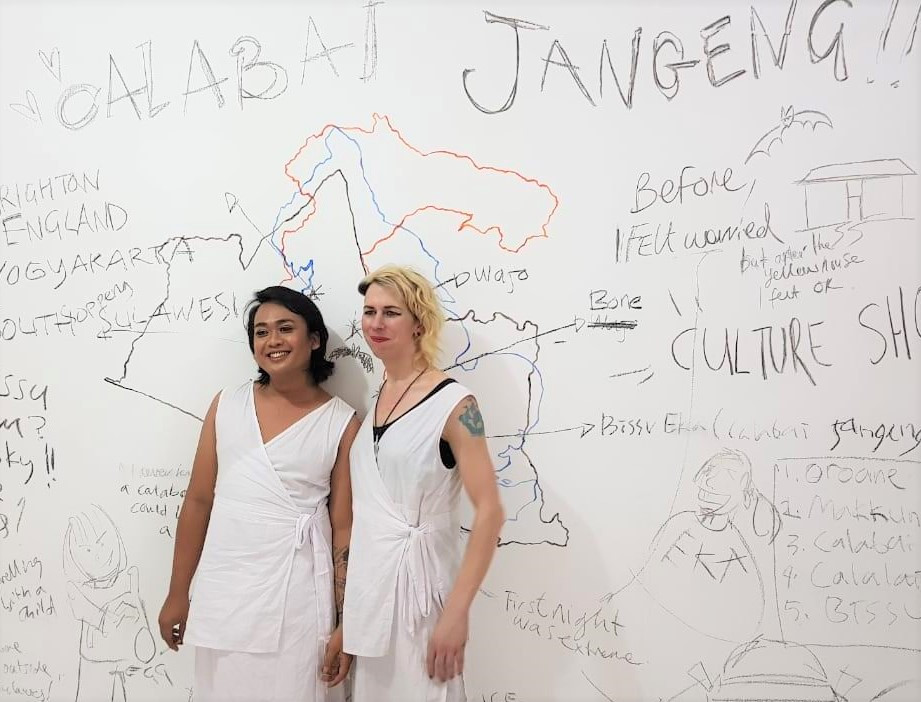Popular Reads
Top Results
Can't find what you're looking for?
View all search resultsPopular Reads
Top Results
Can't find what you're looking for?
View all search resultsTamarra Pertamina finds her home in acceptance
For some people, home is a place where you can kick back and relax, finding peace by leaving your worries outside the door.
Change text size
Gift Premium Articles
to Anyone
F
or artist Tamarra Pertamina, home is where she can find acceptance, wherever in the world that may be; not about a building’s façade or condition.
“Only when I am accepted by my neighbors, then I could truly feel like I have a home. I think of my current rented abode as my home because I am in good terms with my neighbors [...] It’s different when I lived in a rooming house because it was a men’s only place, so I didn’t feel at home because I couldn’t be myself,” she recounts.
Identifying as a transwoman, Tamarra was born in 1989 in Tasikmalaya, West Java, to a traditional Muslim family who enrolled her into a pesantren (Islamic boarding school) at the age of 7.
Struggling with her identity, she found herself in Jakarta at the age of 15, taking on sex work and becoming active in campaigning for transgender rights.
The moniker Tamarra Pertamina, derived from the state-owned oil and gas company, is both a symbol of hope and a reminder for herself.
In a 2018 interview with Hyperallergic, Tamarra said almost every Indonesian needed Pertamina and she hoped she could fulfill the needs of many through her work.
On one hand, Pertamina is the fuel that keeps her fire alive, but that fire can also burn her, so the name serves as a reminder to find her balance in confronting the social issues in her work.
Interestingly, Tamarra identifies as a waria (a portmanteau of wanita and pria – woman and man respectively) instead of the increasingly popular term transpuan (transwoman).
Her reason for this is simple: It is an identity recognized by the state, born during then-Jakarta governor Ali Sadikin’s term in 1968.
First recognized as wadam (wanita and adam), the term waria replaced it in 1978 due to objections by some religious leaders as well as the then-religious affairs minister of Alamsyah Ratu Prawiranegara, who proposed the new term.
“That has become my point of reference when people – or even my friends — say that waria aren’t accepted by society, then I can proudly state that it is an identity accepted by the state,” she told The Jakarta Post by phone after an Instagram Live session hosted by Goethe-Institut Indonesien.
“As for acceptance, it is only up to a certain part. Even the president is elected by some 50 percent of adults, so it’s impossible to be liked and accepted by everyone, especially myself as someone who is considered very different by the public.”
Because of the term’s history, Tamarra said she was much more comfortable in being referred to as a waria, a much preferred term over transgender jokes like being called TransYogya or TransJakarta.
Symbolic: Tamarra performs the monologue 'Poo poo poo' in 2017 at Kedai Kebun Forum. (Courtesy of Agnes Christina/-)Tamarra’s jump into the art world was not because she wanted to create art per se but from a desire to create.
In 2008, Tamarra moved to Yogyakarta to study at Gajah Mada University. However, the tuition fee was high, so she had to find a way to survive. From that point, she found a community of waria who taught her busking, and she also took up sex work.
In 2012, she met a group of artists – Ferial Afiff, Lashita Situmorang and Jimmy Ong – through their Makcik Project, which worked actively with waria across Yogyakarta.
From there, she learned a lot about the arts, including words she did not understand but thought as cool. By asking questions to established artists, she finally found the desire to create.
She then decided to stop busking and sex work entirely and offered the artists whose numbers she had gathered to clean their homes as a way to get into their studios.
By coming into the studios, she learned and understood how the artists’ creative and creation process unfolded. From the unused art supplies she gathered, she would learn these processes herself.
That year, Tamarra was also invited to her first public performance as an artist: a performance art piece that she didn’t even understand at the time near the Indonesian Arts Institute of Yogyakarta’s postgraduate building.
During the piece, her performance was a response to several trees that had been cut down by force, which the students were displeased about.
“For my first performance, I positioned my body as a tree that is being cut down. Coincidentally, my hair was quite long at the time, and I held a pair of scissors in front of my chest, wrapped my body in barbed wire and requested to be thrown into a burning pile of wood,” she recalled.
The people in attendance kept trying to discourage her to do so, but Tamarra noted that she was trying to express her similarity to the trees – cut down by force, like the lives of many waria who did not receive the opportunity to live humanely.
Reflection: The piece is meant to be reflective piece on identity and the artificiality of one's appearance. (Courtesy of Yulian Ardhi/-)From then on, her work has been exhibited in various venues and exhibitions, including the Jogja Biennale; Shout! in Melbourne, Australia; as well as a sponsorship from the British Council.
With the pandemic still in full swing, Tamarra’s planned solo exhibition at Rubanah has been put on hold until next year. In the meantime, she is staying in Jakarta to volunteer at mental health, environmental and animal rights nonprofit group Kopi Panas Foundation while still studying at Sanata Dharma through the internet.
The upcoming exhibition centers on home, in this case, her mother’s womb. The idea originated from her prior research on the bissu of the Bugis tribe in South Sulawesi.
The Bugis tradition recognizes five distinct genders, in which the bissu embodies both masculine and feminine traits and take on revered roles such as community priests, seen as the intermediary between humans and the gods.
Tamarra said one of the reasons she wanted to return to her mother’s womb was to find out whether she would face resistance in there and she wanted her audience to be more involved in the goings-on of the womb as well as encouraging them to reflect.
“I first researched about the bissu because of my feelings of disappointment for my partner, who left me after 10 years together. The reason was absurd – just because of a woman – to me, but it may have been a sound reason to him,” she said.
“The [upcoming] exhibition is my effort in recreating my mother’s womb, because I feel the urge to return there. I wonder what’s inside there that made me born ‘weird’ like this.” (ste)













